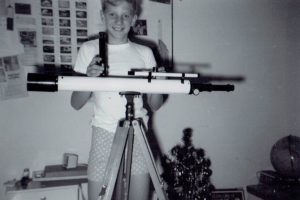As long as I can remember I have been fascinated with the night sky. The stars and planets elicited many hours of viewing and study, even as a very young boy. My first telescope was a Tasco 50mm spotting scope on a tabletop mount that I received around age 8. I soon learned that it was not easy to use the 50x of the scope while balancing on a TV tray! Even then many a night was filled with looking at the sky. In fact, since I was an asthmatic and was often sick, the 50 mm was used many a night indoors looking out through the windows. Not a good view but a view none the less!
In fact I really wanted to be an astronomer! Unfortunately, I was a full blown dyslexic and though my letters reversed in 2nd grade my numbers did not, or at least they didn’t until I was in my mid 40’s! In fact I really enjoyed teaching a pre-algebra class in summer school one summer ( I was in my 40’s) even though I never took even one college algebra class! Surprisingly enough, all of my students from that summer did quite well in regular High School Algebra the next year! Still I knew from a young age I was never going to be an astronomer with my math deficiencies. So eventually a BA in history and a MA in Divinity were the outcome of my education.
Aperture fever took hold after the 50mm and a campaign was begun to get my parents to buy me a larger scope. A 3″ Newtonian was just the ticket. The Sears Catalog soon began to open to the telescope page all by itself since I spent so much time looking at the ads! The 3″ arrived in my life on Christmas morning and soon the new size was paying dividends. The Andromeda galaxy, M 42 (the great nebula) and all of the planets except Pluto were sought after and examined. (I looked for Pluto for many hours but a 3″ Newt was not enough scope to do the job from a backyard in Scottsdale, AZ!) Eventually I broke the mirror while cleaning it and another campaign for a telescope was begun.
This time I decided that I needed a Sears 90 mm equatorial refractor! These telescopes were quite functional with good optics and OK mounts. They still demand a high price on the used market. Unfortunately, my parents decided that I seemed to have a lot of accidents with my scopes and that the investment needed for an 90 mm was a bit too much. So the next Christmas I opened a long rectangular box to reveal a Sears 60 mm Alt/Az refractor with sun filter and finder, plus 3 eyepieces with a 2 x Barlow. See the image above! This instrument led me from a celestial sightseer to a serious amateur scientist!
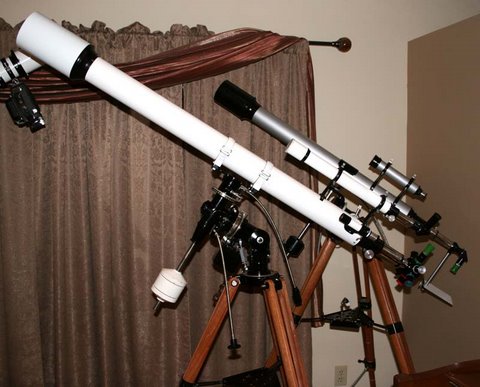
Mars was soon at opposition. Wow, what a view! I could see Srytis Major and the polar caps. Once, I even believed that I saw Lowell’s canals! I kept a very complete observing notebook like my hero Clyde Tombaugh did in the book ‘The Search for Planet X” by Tony Simon . After filling it’s pages, the notebook was sent to Lowell Observatory for their perusal just like Tombaugh did. Lowell Observatory’s response was very cordial and the notebook was sent back, but no job offers ensued! After reading many books referring to doing science by observing and reporting variable stars, I decided this was my way into real science. So I sent off for my first variable star charts from the American Association of Variable Star Observers. With eager anticipation I checked the mailbox every day waiting for the intro package. It finally came and I could not wait for night to come. After 2-3 hours I could not find a single variable. This experience was repeated over the next 2 weeks and I finally gave up! Since I was the only one that I knew about that had an interest in stars, much less variable stars, I was doomed to failure due to ignorance. Remember this was pre-internet days so getting info on club meetings was not as easy as it is now! It was not until many years later that I was to actually find and record a variable star.
College came along and much of my astronomy interests were put on hold. Not completely, however. Attending Northern Arizona University my freshman year I was able to attend observing sessions at Lowell Observatory and even convince the staff to stay a little longer and let me use the 24″. The most memorable object was M 57. You could see a green cheerio shaped ring with a little violet star in the middle. Amazing sight! I also got to use a 10″ Newtonian for my beginning astronomy class. After the lab chores were done and my lab partners were off getting drunk at the local bar I would stay on the roof of the science building using one of several 10″ reflectors to look at a variety of objects. We also had occasion to look through the 24″ reflector at the NAU observatory for our class.
After college and it’s 12 hours of introductory astronomy courses there was little time for viewing. I still read astronomy books but seldom actually got to look through a scope. I attended Golden Gate Baptist Theological Seminary and lived on campus in Mill Valley, CA. The Seminary sat on a hill overlooking the bay and San Francisco was one of the most magnificent sights I have ever seen! Unfortunately, because of light pollution it was terrible for astronomy. My interest did not wane however, since I would get to take trips to Yosemite National Park and be able to see the stars in a dark and pristine sky! It was so dark that it was often hard to pick out the constellations due to the overwhelming number of stars that could be seen. Most of my time was spent studying, working and eventually wooing my wife.
Marriage and kids followed to the detriment of the pursuit of my astronomy passion. After working 50-60 hours a week, changing diapers and trying to stay sane in a stressful service job, astronomy was only to be done by an occasional book checked out of the library. Each year I would say, “This is the year that I will buy a “big” telescope.” But after a year of medical bills, moving expenses and buying kid’s clothes the time would pass, then another, without the big scope.
Finally, we had to move in with my parents for a while between positions. I got out my old 60 mm refractor and began to clean it. A small scope can still see thousands of interesting objects and is better than no scope. After carefully taking out the lens elements and cleaning each one with distilled water and a drop of dish soap I turned around to set a part on another counter and I heard one of my kids say, “Daddy, what’s this?” then I heard the sound of breaking glass! So much for the 60 mm! It was not premeditated or malicious, just curiosity and butter fingers! Still, now I had no telescope at all!
After much thought I called Coulter Optics, a small maker of Dobsonian telescopes and asked them if they had any mirror seconds. They did and it was only 25 dollars for an 8″ mirror! So for the royal sum of 50 dollars (which was hard earned when you are so poor you have to live with your parents)I purchased the mirror and secondary to build an 8″ Dobsonian telescope. With another 15-20 dollar investment in threaded rods and 2×2’s along with my dad’s ample scrap pile, the telescope was built in an afternoon. It was ugly but functional. The focuser was off of the broken 60mm and the .965″ eyepieces were also from that scope. The mirror was not of the best quality but gave good views until you went over 150x. The old Huygenian 4mm eyepiece however, gave great views. The field of view was so narrow that it eliminated most of the bad optics. Now my appetite was whetted for some real science. We moved to my in laws empty trailer on their property in Missouri where I observed in non-light polluted skies while looking for work. The computer company I had been working for laid me off before they were sold to a Taiwanese firm.
An ad appeared in Sky and Telescope Magazine asking for ground based observers to back up an amateurs use of the Hubble Space Telescope. The project was to look for coma (dust or water) around several bright asteroids. The first observing week was clouded out. I decided to get serious about this project so I contacted Lowell Observatory and requested time on their 31″ NURO scope. The request was granted and the excitement began to mount. Until they cancelled! The post-Doc who was supposed to assist me moved to another job! As a backup I contacted the Astronomical Society of Kansas City to see about using their 30″ but it was broken. We soon moved to Weston Missouri where I became the pastor of the Baptist church. After dealing with the flood of 1993 and needing a couple of days off I began to look for other local observatories where I might get some observing time. So after much calling and emailing, arrangements were made to use the Wichita University observatory outside of Wichita, KS at Lake Afton. The day of observing dawned bright and clear. To pass the time I went to Hutchison, KS to the space museum. As I was headed back to Lake Afton a thin streak of cloud appeared on the western horizon. By the time night came, it was pouring down rain! After 2 days in a motel I called it quits and left! It rained for a week straight! The next observing week for Hubble was also rained out!
So much for doing science! However, this experience did rekindle my interest in variable stars. So while I was down with adult onset Whooping Cough a few months later, I sent a letter to Janet Mattai of the AAVSO indicating my interest in variable stars. Several weeks went by before I received a reply. Turns out I had forgotten to put a return address on the envelope or letter! Janet tracked me down through my membership in the Astronomical Society of Kansas City! While still coughing periodically, I went out to look for Z Ursa Majoris. My expectations were quite low after the experience as a youth. Within 20 minutes I had found the star and even recorded it’s brightness! Success is sweet! When younger I had fallen victim to the same problem as Leslie Peltier in his book “Starlight Nights.” My lack of experience caused me to underestimate the field of view of the eyepiece, thus making it difficult to pick out the variable from the back ground stars.
After leaving full time ministry my wife and I took jobs on the Navajo Indian reservation. The sky conditions were much better than they were in Las Vegas, NV where I occasionally set up a 60 mm Meade ETX refractor. With all the light pollution, Las Vegas was not ideal for astronomy! After doing a star talk at Great Basin National Park during the summer I was very glad to get to the pristine skies of Ganado, AZ in November. I asked around on a forum if anyone had a telescope they would be willing to donate that was a bit more user friendly than a Meade 60 mm ETX or my 8″ homemade telescope. A guy gave me a Meade 10″ Reflector telescope! This was big and bulky but I could take it apart and store it in my closet. The drives were balky and the telescope eyepiece would end up in weird angles but it was a lot of fun to use. This was used for a number of years and even taken to Scottsdale, AZ for a year where I taught at my old high school Alma Mater. Rent in Scottsdale was high so when I was offered the head football position back on the reservation we jumped at the opportunity!

Chinle, AZ, was a good place to teach. We lived about 15 miles away from the high school at Many Farms. AZ. The skies here were much darker than around the lights of the school. Plus we had a bigger backyard to set up the scope. Since I have had back problems off and on for years I opted to trade the 10″ reflector for a go-to Meade 90 mm refractor. You could lift the scope and mount with one hand. It had the typical out of control slew issues that early Meade’s of this model had but after some web surfing I found out that you had to keep your connections very clean on your cables. This scope was used almost every clear, night.
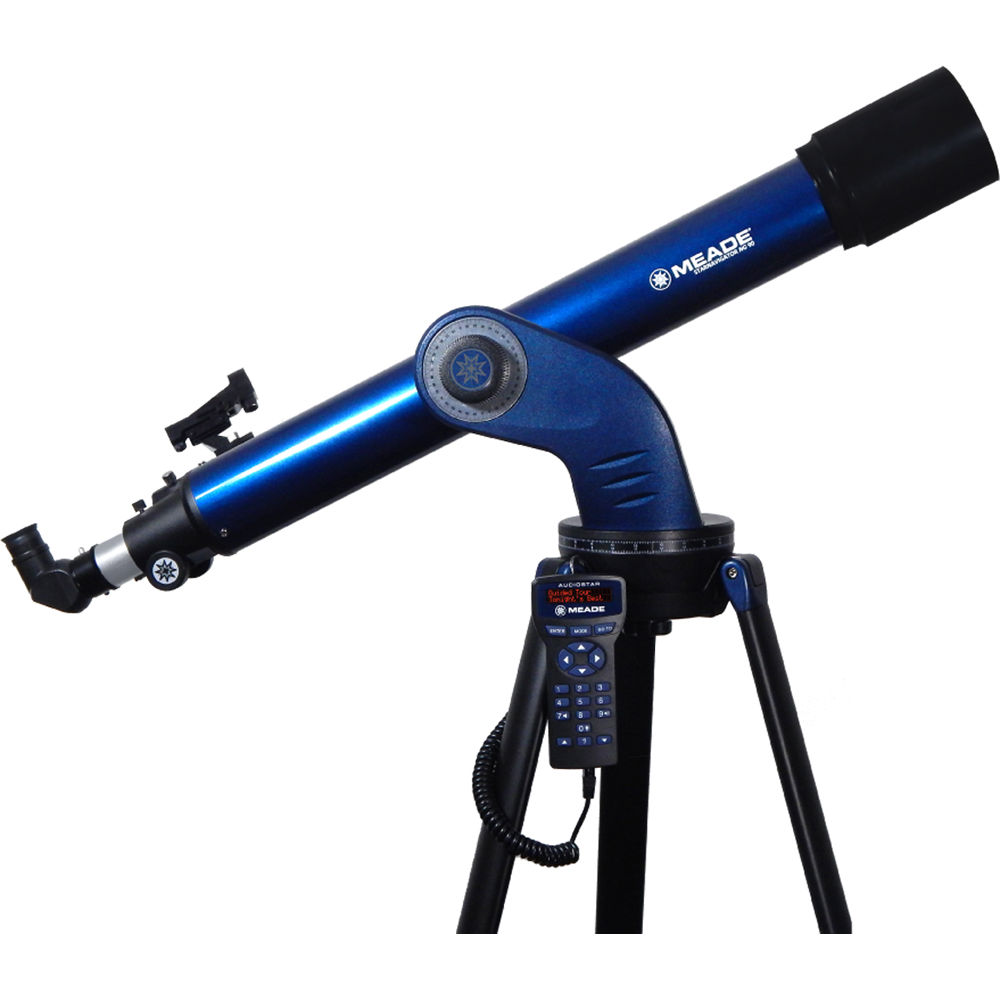

After having made a promise to my wife that someday we would live closer to her parents I was offered a teaching job in Missouri about 3 hours from the in laws. This was not a great time or place for astronomy. Our first year there was in a difficult school with horrible weather. We missed 2 weeks of school due to severe ice storms! The school opted to use my Social Studies position to attract a new basketball coach (he was fired after his first season!). We moved to a town an hour away. It was a larger community with more light pollution but I did get to see the comet that should not have been a comet!
My wife and I eventually moved to Deming, NM where I resumed my career as a pastor. Deming is a much better place to do astronomy than just about anywhere else we have lived. I had decided that I was just going to stick with astronomy for fun! No camera’s, gratings, or video cameras! Soon after we moved there I noticed an ad in the Cloudy Nights forum for a 6’ Celestron Refractor with a Skyview Pro mount for 350 dollars! I bought it and had my wife pick it up on a trip to Missouri to see her parents. It was too big to take on a plane so my son in Oklahoma brought it out at Christmas and it took up his whole back seat! This is a serious sized instrument. It had issues like weight and chromatic aberration but it was still the best telescope I had ever owned at that point. The 90 mm Meade was given to a middle school girl who has gone on to college and been a great Divison II golfer. Also gave away to a young man in our church the 60mm whose article is on the website.
This new scope inspired me to want a CCD to do photography. So much for “just for fun” visual observing. After some research and noticing that virtually every serious camera was way out of my price range I was a little discouraged. So I called a friend in Arizona, a person that had attended one of my astronomy classes at Mohave Community College. He sold used astronomy equipment on EBay but at that time did not have anything I could afford. He did suggest that I contact a friend of his that had a SAC-7b modified and cooled webcam that he might be willing to sell. So a deal was concluded and I was the proud owner of a used SAC-7B camera! The SAC series were modified webcams and the SAC 7b could take cooled long exposure images. The purchase of this instrument led to doing photometry of a star in M 42 with the built in filters on the color chip. The findings were presented to the joint SAS/AAVSO meeting in Big Bear, CA in May of 2009. Some of this paper helped to encourage the development of a technique and manual to do photometry with a DSLR by the AAVSO. At that meeting I purchased a Star Analyzer from Oliver Thizy who was giving a talk on spectroscopy. This began another area of science observations!

When I got back from this meeting we had to move to another house and that is where the idea of the TRO came in. Instead of breaking down the scope every night and carrying it into the garage I built a wheeled platform that could be rolled out of the garage into the driveway.This was the early beginnings of the TRO! Though the definition of Observatory is a place where you observe, my postings about the wheeled platform was kicked out of the Cloudy Nights Observatory Forum. I was told that it did not meet the criteria of an “observatory.” Still it was my observatory so I was happy.
A few months before we moved out of town to a dark site, I had upgraded the mount to a Celestron AS-GT GOTO mount. It was supposed to be too light for a 6″ refractor but the mount handled it quite well. Another change was the acquisition of an SBIG ST-7E CCD camera. Arne Henden of the AAVSO had suggested that I contact a guy in Cloudcroft, NM since he did serious science with AAVSONet telescopes. After emailing him several times he said “Hey I got this ST-7 that I am using as a doorstop and if you come up I’ll give it to you.” My wife and I headed up there to visit soon after. Sure enough, he was using the case with the camera in it as a doorstop! All the pieces were in place to begin to do some serious observing.
After much experimentation and time, a working scope began to emerge. We had to move again so much of my observing plans were temporarily on hold. This new location was 5 miles south of town and an even better site for astronomy. In a flash of brilliance I decided to leave the telescope and mount outside covered with a tarp. The tripod was tightly attached to a large trailer screw that was buried several feet into the ground. While on a trip to Phoenix our house had a 100+ mph wind that pulled up the screw and threw the scope against a fence. The AS-GT mount was broken into 2 pieces but everything else was OK! At this point I decided that I needed a new mount and a optical tube assembly (OTA). After much study I decided on a larger FOV and bought an Astronomy Technology 8″ Newtonian Astrograph. To mount this scope I purchased a Sirius mount from a college student in Florida on Astromart. The mount did not come with a hand control but it did come with a EQMOD cable to hook it to a computer. Thus the basic setup of the TRO Deming was born.
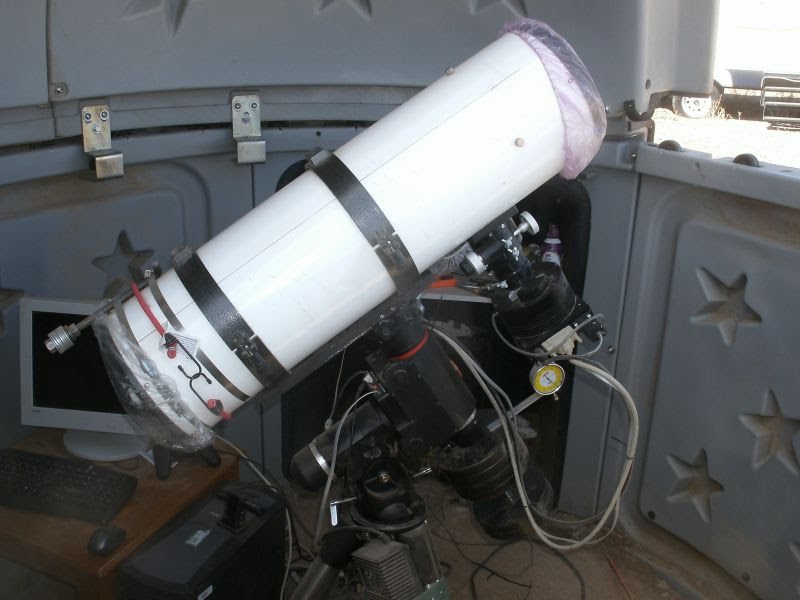
In July 2011 I received a call out of the clear blue sky from a guy in our area. He mentioned that he had an 8″ LX-200 GPS telescope and wanted to know if I would be interested. I asked how much and he told me that he did not want any money for it but that I could just have it along with a Meade DSI Pro camera and lots of accessories. After I recovered from that part of our conversation he dropped another bombshell! If I was interested he also had an unassembled Skyshed Personal Observatory Dome (POD) that I could have as well! Needless to say I jumped on this once in a lifetime opportunity, borrowed a trailer and picked up the scope and dome. Over labor day 2011 a friend of mine and I assembled the POD and the TRO was up and running!
The Temple 20 is a refurbished Meade LX200. It was modified with metal gears and a cooled custom carbon fiber tube. The scope initially had a problem with slightly oval stars, but it was not a big problem to start with but it kept getting worse. It turned out to be the cooling fan on the ST-402 CCD camera (camera was on loan from the AAVSO). It was running at a point that caused vibration in the scope. A couple of resistors to slow the fan motor down solved the issue.
In February 2014 I took a job teaching science at McCurdy High School in Espanola, NM (tried to retire from ministry again). To facilitate the move I sold my Skyshed POD (help pay moving costs) to a friend of mine and bought an 11″ Celestron from a friend. It was a telescope that he had just about completed when he decided to quit astronomy. So he was willing to sell it to me, cheap! It is an 11″ SC (Schmidt-Cassegrain) with a custom carbon fiber tube, enhanced cooling, automated focusing, medium format CCD camera and a full set of scientific filters. It was installed and tested in March and April 2014. I had a series of productive runs in May and June. However, I was offered the position of senior pastor at First Baptist Church Espanola, NM in June. We moved to the parsonage in July and TRO Espanola was moved. The new version featured a functional concrete floor! Our new location was only 2 blocks from the old location but had a much better view of the sky. One positive change was from the old ST-7E camera to the ST-2000 camera that came with Temple 28. The speed of the uploads were much higher in the ST-2000 because it uses a USB 2.0. The ST-7 is a parallel port camera and took up to 45 seconds to download from the camera to the old single core computer. So instead of 150 images a night I was supposed to get 400+ images a night of 3 megapixel size! Big improvement in speed and quality. Unfortunately the ST-2000 got some type of electrical spike and caught fire! Toasted the camera and the cost to fix it is higher than buying a used one! So back to AAVSO for assistance. They loaned me an ST-402 with B,V,I filters.
We knew going in that our time in Espanola would be limited. In the summer of 2016 I retired (again) and we moved to Alamogordo, NM where I was teaching science and coaching JV football. The weather was oddly not terrific and I ended up working 2-3 jobs to pay the bills. After football was over I did get some imaging in with the AR102 (see the review page) and a ZWO120MC camera. TRO was not set up due to the fact that a week after we moved to Alamogordo, First Baptist Church of Lexington, Missouri, called me and asked if I would be interested in being considered for the position of senior pastor. We moved to Lexington in March of 2017 where I have come out of retirement to be the senior pastor.
Recently I was fortunate to be able to buy a used SBIG ST-8E CCD camera. When this camera was new is sold for around 6,000 dollars. I got it for 225 plus shipping. It is a medium format 3 megapixel camera with a parallel port connection. It takes 67 seconds to upload one image. This is way faster than what it was on my old single core computer. Still it is a very high quality, cooled, CCD camera. This type of camera makes doing quality photometry relatively easy so it was upgraded with a CFW-8 wheel and filters and used on Temple 28. I have been using the ST-7E and ST-8E on a High Point AR102 refractor telescope while preparing to set up a more permanent observatory with some success. In fact the AR102 and ST-8E combine to give a wide field view of the night sky.
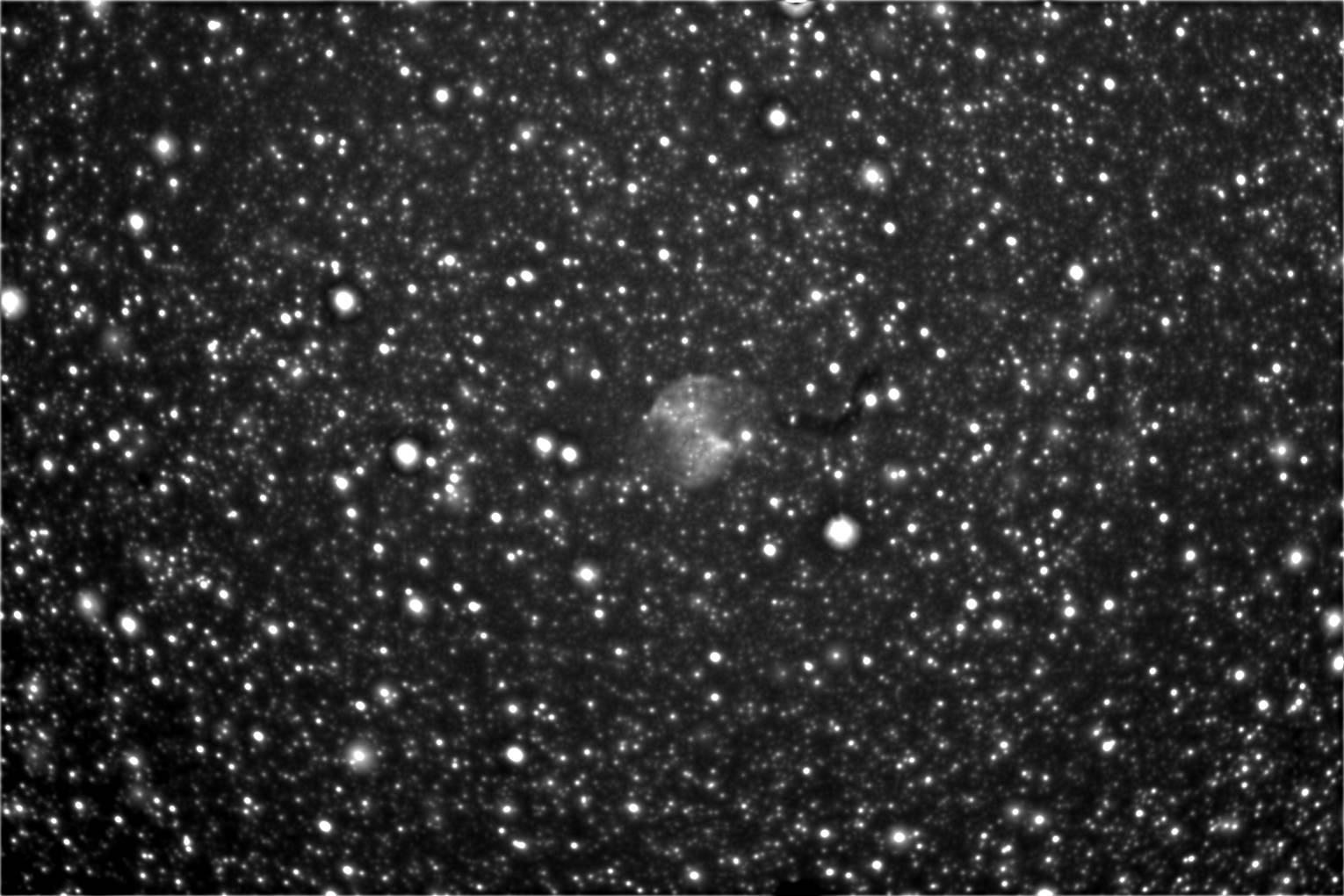
A friend of mine let me buy a ATIK414 camera from him. This is a medium (large to me) format mono camera with a manual filter wheel. With the addition of a photometric V filter it makes a usable large format photometry instrument couple with the AR102. A recent addition is a Synscan Hand Control unit that allows more flexibility. As this is written it is still being tested and set up for automated use.
Temple 20 is the 8″ LX200 that will eventually be used for spectroscopy. It needs the Meade wedge beefed up before it is usable for much of anything very serious. It is a chore to find time to setup and maintain 3 telescopes so it is waiting for a calmer time to begin work.
Overall, I am getting to live out a lifelong dream! The Central Star of Planetary Nebula project that was started in 2010 to study the white dwarfs at the heart of Planetary nebula, continues as well as observing close over-contact binary stars. Below are some telescope reviews that have been submitted over the years featuring the TRO scopes.
